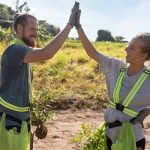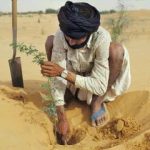Training for Individuals, Communities,
Nonprofits, & Local Governments
Become Adaptable and Resilient
Get road-tested, affordable, do-it-yourself solutions for a changing climate that YOU can launch NOW!
Start today with ‘8 Steps to Cut Your Carbon Footprint 50%.’
A complimentary copy of the book is provided to students in the teacher-led climate courses as a project development resource.
This field guide will show you in simple, practical steps how to set up a climate action plan within a community.
A Field Guide To Community Based Adaptation

By Tim Magee.
Foreword by Howard White
Published by Routledge, Oxford, England.
248 pages
‘Tim Magee, and his colleagues at CSDi, are to be commended for producing a book which should change the way development is practiced, and so directly contribute to the improvement of millions of lives around the world.’ – Howard White, Executive Director, 3ie, USA
This is the exact, published, PDF version of the paperback book.
Download the book: $19.99.
The world’s poor will be the most critically affected by a changing climate―and yet their current plight isn’t improving rapidly enough to fulfill the UN’s Millennium Development Goals. If experienced development organizations are finding it difficult to solve decades-old development problems, how will they additionally solve new challenges driven by climate change? This book illustrates how including community members in project design and co-management leads to long-lasting, successful achievement of development and adaptation goals.
The following Table of Contents and the introduction to the book provide a good, quick overview of the process of developing adaptation to climate change projects.
TABLE OF CONTENTS
List of Tables
Forward
Introduction
SECTION 1. LOCAL CONTEXT
Chapter 1. Community: Local Need
communities, challenges and sustainability
developing a project based upon a participatory needs assessment
facilitating a participatory needs assessment
creating a simple project outline
Chapter 2. Community: Local Climate Knowledge
facilitating a participatory capacity and vulnerability assessment
summarizing and correlating the results of the assessment
coping strategies and adaptive capacity
revising the project outline based upon new findings
Chapter 3. Climate: Scientific Climate Information
researching scientific climate change information
assessing risk and summarizing local scientific climate change information
Chapter 4. Challenge: Local Context
comparing local knowledge to scientific climate knowledge
modifying the project outline based on new scientific information
completing a revised project outline reflecting local need, local knowledge and scientific climate knowledge
SECTION 2. DESIGN
Chapter 5. Solution: Adaptation Activities
researching solution-based adaptation activities
the program and activity solution list
mainstreaming: integrating adaptation activities and traditional development activities
verifying activity effectiveness through evidence
community ownership: feedback, input, and engagement
assessing NG0 expertise
Chapter 6. Project: Management & Funding Tools
developing a logical framework
measuring your success
the detailed budget
the project schedule
project summary: the compelling two page fact sheet
how will you organize a donor presentation?
SECTION 3. SUSTAINABLE IMPLEMENTATION
Chapter 7. Launch: Partnering with the Community
preparing for a team building workshop
forming a community based project management committee
Chapter 8. Sustainability: Capacity Building for Community Takeover
engaging management committee members in project activities
empowering committee members to co-manage the project
community capacity building: adaptation skill set workshops
two-way knowledge transfer
the first community skill set workshop
Chapter 9. Impact: Milestones into the Future
participatory project monitoring and evaluation
milestones: post-project monitoring and evaluation
finding future expertise and resources to address future challenges
developing a long-term project management plan
packaging and presenting this post-project toolkit
SECTION 4. TOOLS AND FIELD GUIDES
Chapter 10. Tools and Field Guides
knowledge transfer: developing field guides, lesson plans and workshops
field guide 1: participatory community needs assessments
field guide 2: participatory capacity and vulnerability assessments
field guide 3: preparing garden beds and planting seeds
field guide 4: soil restoration and conservation for smallholder farmers
field guide 5: participatory mapping of soil and water resources
field guide 6: agricultural soil and water management for sloping land
field guide 7: household rooftop rainwater harvesting
field guide 8: community level water harvesting
field guide 9: overview of developing a community-based disaster risk reduction plan
field guide 10: diversifying livelihoods through market links
SECTION 5. RESOURCES
Appendix: Background
Recommended Resources
Bibliography
Index
A Field Guide To Community Based Adaptation
Why Write This Book?
Two of the most important groups of people in community based adaptation are field staff—the people on-the-ground doing the work—and the communities that they work with. This book has been written for you—a development practitioner who wants to begin working today, with your communities, to successfully adapt to the climate challenges they are facing.
The most well-intended generosity of donors and the most carefully researched development program won’t have the intended impact if trained, effective field staff aren’t on site to implement projects—and if well-prepared communities aren’t ready to take over when NGO staff depart. Without the cooperation of these two groups in project design and management, project outcomes run the risk of coming to an abrupt halt at grant’s end—undermining the long-term impact that all parties had worked so hard for.
The world’s poor will be the most critically affected by a changing climate. These human beings have been struggling for decades with poverty, malnutrition, poor health, and a lack of access to education. Development professionals are beginning to realize that for many communities, their plight may not be improving rapidly enough to reach the UN’s Millennium Development Goals by the targeted date. If experienced development organizations are finding it difficult to solve decades-old development problems, how will they additionally solve new challenges driven by a changing climate?
An underlying cause—with a veiled solution—may be that development hasn’t always included communities in the process of assessing need, designing project activities, having a stake in project management, and taking over project stewardship at grant’s end. Cutting edge development now sees this community participation as paramount for maintaining the positive outcomes that contribute to long-term impact. This is the beauty of community-based adaptation (CBA): it both improves development results by fully engaging community members as partners and owners—and at the same time increases the community’s resilience to a changing climate through sound adaptation practices.
A second underlying cause for a lack of forward motion in development may be that many development practitioners don’t have access to the field tools, sound information, and training necessary for improving project impact. Without effective tools and methodologies, how can these practitioners learn to design projects that are both sustainable and impact oriented? How will they learn to introduce CBA activities into traditional development projects when resources are already stretched thin?
The goal of this book is to increase the effectiveness of community-based adaptation so that many, many more people worldwide can enjoy increased resilience to climate change challenges. This books hopes to do this in two ways. One: by leverage. If this field guide can help get sound tools and techniques into the hands of in-country staff, they will be better prepared to design and implement impact-oriented projects for increasingly greater numbers of people. Two: encouraging in-country staff to engage community members in project design and implementation will increase the likelihood that positive project outcomes will be sustained by communities for the long-term.
What the Book Will Provide You
Where does one turn to for information on designing, launching, and managing CBA projects? For many staff members it may feel overwhelming to launch an adaptation project. Where do you begin? What practical tools are working today? How do you convey climate change concepts to a community? Together, through this book, we will explore the full process of developing CBA programs.
This field guide provides a system for field staff to use in developing successful projects that can be co-managed and sustained by communities, and includes the tools needed to:
-assess and organize information about climate challenges and vulnerabilities that communities face
-work side-by-side with communities to develop long-term, sustainable adaptation programs
-link together development, disaster risk reduction, and adaptation activities into sound projects
-empower communities to take full charge of programs once up and running
Why is community engagement in project design and implementation important? A criticism of the traditional project cycle is that when an NGO completes its two-year project, they leave their community at the helm of project management without sufficient training and technical support—and perhaps even without much interest in the project. For example, how many communities have you been to and seen two-year-old water projects that no longer function?
Unlike a childhood vaccination program, where once vaccinated, neither the child nor the parents need to oversee project continuation, CBA projects are for the long-term: decades. If they are to be successful projects, the behavioral changes, forest management schemes, or the water harvesting systems you promoted will need to be maintained indefinitely—or the positive results will wane. Community based adaptation ensures that communities are engaged from the beginning of project concept and are involved in each important step of the process. Community engagement creates the caring ownership that sustains these important adaptation components for the long-term
A Field Course in a Book
The book is arranged in a progression where each chapter represents one sequential step in the process of project development including problem assessment, project design, project launch and community take over. Each chapter has the tools needed by field staff to complete that chapter’s step in developing a real, on-the-ground project. So that you can stay on track, the field course follows one consistent, example project as it grows and develops during the step-by-step field assignments.
The field activities in each of the chapters are designed to be accessible by people at different levels of your organization—and to be able to be started quickly. The low cost/no cost activities are simple enough for implementation by field staff with basic skills, and for adoption by community members with basic capacities for sustaining activities. You can get started empowering your community today with this very powerful set of tools. For those of you wanting to explore individual techniques in greater depth, each chapter provides recommended resources for further study.
CBA Project Activities
There is confusion over what adaptation activities are. Many people are expecting a palette of brand-new technologies to begin arriving any day now: adaptation silver bullets. But problems caused by a changing climate will likely pose a risk for livelihood, health, food security, and access to water—many of the same things that traditional development projects struggle with. CBA project activities will in many cases be the same activities used in a development project—but simply used to solve a different problem: challenges driven or intensified by a changing climate.
The book will therefore promote crosscutting initiatives that combine traditional development, disaster risk reduction (DRR), and CBA activities. In a crosscutting—or mainstreamed project—an activity can be incorporated specifically to address a traditional development challenge, a challenge related to climate change—or perhaps a solution specifically designed to reduce risk associated with disasters. Combined, these interrelated activities work in support of each other and facilitate community members in developing resilience, safety, and prosperity. For example, by adopting the use of drought resistant crops, farmers can adapt to a drier climate. Through improved health, nutrition, and preparedne ss for disaster, communities will reduce their vulnerabilities and increase their resilience to climate change impact.
The Steps
How do you know if your community project is linked to climate change? What practical, CBA tools, solutions, and activities are available today that you can include in your project? In order to address these questions the book offers two approaches. The first approach is to use the step-by-step field assignments (one per chapter) that show how to design, launch and manage a sustainable CBA project. The second approach is a collection of 10 hands-on field guides about individual CBA activities for readers to use in solving classic climate change challenges.
In Chapter 1, you will learn how to assess the challenges that a community faces. In Chapter 2, explore their understanding of how the climate is changing around them, and learn how to uncover the adaptive solutions which they have developed on their own. In Chapter 3 you will research scientific information about climate change for your specific location. This will help you determine which are the most likely climate change (CC) scenarios that are unfolding now—and what will play out in the future.
In Chapter 4 you will compare your community’s local knowledge with scientific knowledge, verify that the community’s challenges are linked to climate change, pinpoint underlying causes, and put together a clear definition of the local climate change context. Chapter 5 begins with the selection of specific field activities to use in strengthening community resilience. Before finalizing a project outline, you will confer with the community to get their feedback and input on the emerging plan.
In Chapter 6 you will develop the management and funding tools that you will need for launching the project. Your project outline will be transformed into a logical framework complete with a monitoring and evaluation plan, and expanded with a detailed budget, schedule, and a concise project fact sheet—all for presentation to a donor. The development of each of these documents will be taken in simple steps using downloadable templates and examples.
Chapter 7 quick-starts the section on project implementation where you will organize a community based project management team. In Chapter 8, you will initiate the process of handing the project over to the community as part of your exit strategy. This will include planning for long-term management, and developing a plan for long-term technical support. You will develop adaptation capacity building workshops for community members, and officially launch the project in partnership with the community.
Chapter 9 will help you design a post-project participatory monitoring and evaluation plan so that the community can continue to evaluate their project, learn from their project, and fine tune activities in an effort to stay on course.
Chapter 10 is a collection of hands-on field guides on CBA activities that have been compiled for use in your project. These field guides include a snapshot of the activity, illustrated workshop handouts, and participatory workshop lesson plans. 10 examples of project activities have been chosen that address adaptation challenges that communities face in the areas of water, food security, agriculture, disaster risk reduction, and livelihood diversification. They very likely represent solution-based activities that you could use as-is in designing and implementing your project.
The field guides chosen for this chapter represent 10 of the most universal challenges that communities face in building resilience and in adapting to a changing climate:
-Participatory Community Needs Assessments
-Participatory Capacity and Vulnerability Assessments
-Preparing Family Garden Beds and Planting Seeds
-Participatory Mapping of Soil and Water Resources
-Soil Restoration and Conservation for Smallholder Farmers
-Agricultural Soil and Water Management for Sloping Land
-Household Rooftop Rainwater Harvesting
-Community Level Water Harvesting
-Developing a Community Based Disaster Risk Reduction Plan
-Diversifying Livelihoods through Market Links
I hope that the book will be useful and enjoyable, and will help you in assisting a greater number of people adapt to a changing climate, rise out of the cycle of poverty, contribute to the development of their communities, and lead fulfilled, meaningful lives.
Tim Magee
Index
Here is a PDF Index clipped from the book:
By Tim Magee.
Published by Routledge, Oxford, England.
248 pages
The Kindle and the paperback version of the book both sell on Amazon for $52.95.
Purchase at Amazon US: Now available in a Kindle edition
The Center for Sustainable Development will provide you with the PDF book for $19.99.
This is the exact, published, PDF version of the paperback book.
$19.99
You will receive an email confirmation with a Download link.
“This book provides an insightful and comprehensive field guide to community-based adaptation. Magee brings together an impressive range of tools, resources and case examples in a clear and systematic step-by-step guide, while ensuring that the concerns of local people are kept at the centre of the analysis. This book is a timely and welcome addition to the literature, and will be useful to experienced practitioners as well as newcomers to CBA.”
Lars Otto Naess, Climate Change Team, Institute of Development Studies, UK
“A fascinating and informative guide to a subject of growing international importance. Tim Magee skillfully explains ways to combine external expertise and local perspectives on adaptation to climate change. This useful book should be read by development practitioners as well as students of climate change policy and international development.”
Tim Forsyth, London School of Economics and Political Science, UK
“Tim Magee, and his colleagues at CSDi, are to be commended for producing a book which should change the way development is practiced, and so directly contribute to the improvement of millions of lives around the world.”
Howard White, Executive Director, 3ie, USA
A Field Guide To Community Based Adaptation is the textbook for the following courses. The Teacher Led training program includes a complimentary PDF eBook of the Field Guide.
How to Write Your Rural Climate Change Action Plan
Write a Tribal Climate Change Action Plan
International Climate Change Action Plans
Tim Magee is an internationally recognized climate scientist, researcher, mentor, and trainer who has over 12 years of experience in designing climate change action plans. Mr. Magee is CSDi’s Executive Director, and the author of A Field Guide to Community Based Adaptation, Routledge, Oxford, England.

During the past 20 years, Mr. Magee has worked with 5,000 training participants from nonprofits and NGOs in 154 countries on a wide range of projects and programs about people, the environment, and climate change. He has a background in renewable energy and wrote a pioneering book on passive solar energy for heating homes.
Mr. Magee is available for 1) a live workshop with your group to develop your Climate Action Plan or 2) to consult with you one-on-one about your Climate Action Plan. Contact us here for more information.
This field guide will show you in simple, practical steps how to set up a climate action plan within a community. You will learn how to interview community members about climate challenges, work with them on developing solutions and then teach them how to launch and manage the solutions. By engaging them in this manner you will be instilling sustainability into the plan that you develop.
Scroll down to see a field guide example clipped from the book.
We will show you how to develop solutions specific field guides which include and overview presentation, illustrations which are appropriate for you and your community, and lesson plans for leading workshops in launching the solutions.
These are designed as templates for you to edit for the solutions that you and your community decide upon. That said, these 10 field guides represent very popular solutions that many communities of come up with.
The book includes 10 of these so you can choose the best ones to modify for your needs.
Field Guide 1: Conducting a Participatory Community Needs Assessment.
Field Guide 2: Participatory Capacity and Vulnerability Assessments.
Field Guide 3: Preparing Family/Community Garden Beds and Planting Seeds.
Field Guide 4: Soil Restoration and Conservation for Smallholder Farmers.
Field Guide 5: Participatory Mapping of Soil and Water Resources.
Field Guide 6: Agricultural Soil and Water Management for Sloping Land.
Field Guide 7: Household Rooftop Rainwater Harvesting.
Field Guide 8: Community Level Water Harvesting.
Field Guide 9: Overview of Developing a Community-Based Disaster Risk Reduction Plan.
Field Guide 10. Diversifying Livelihoods through Market Links.
Here is a PDF clipped from the actual book of Field Guide 5: Participatory Mapping of Soil and Water Resources.

Write Indigenous Climate Action Plans
8 Week Class
Hands On

How to Write a Climate Action Plan
8 Week Class
Hands On

Fund Your Climate Action Plan
8 Week Class
Hands On

Launch Your Climate Action Plan
8 Week Class
Hands On

Manage Your Climate Action Plan
8 Week Class
Hands On

Intl. Community Based Adaptation
8 Week Class
Hands On

Breaking News: Climate Solutions
Monthly
Subscribe Now!
We’re dedicated to bringing you uplifting news, innovative ideas, and practical actions to combat global warming.
.
Use our resources to discover your own sustainable climate solutions. Together, we can make a difference in our communities and beyond.
Copyright © 2008-2025, Center for Sustainable Development, Inc. All rights reserved. CSDi is a U.S. registered 501(c)(3) nonprofit organization that specializes in providing sound, evidence-based information, tools and training for climate change and sustainable development for development and nonprofit professionals worldwide. Visit our training catalogue.